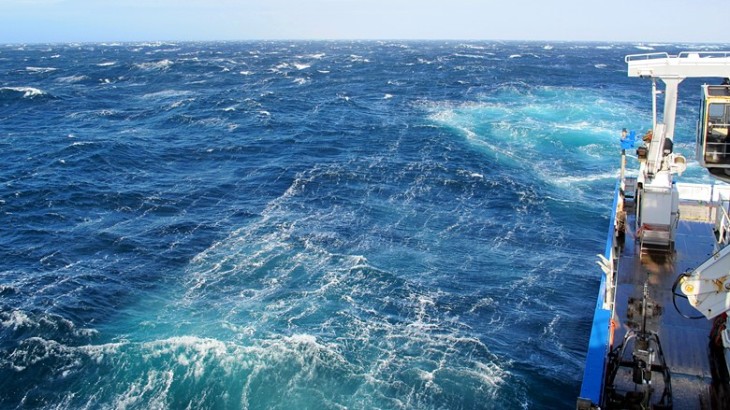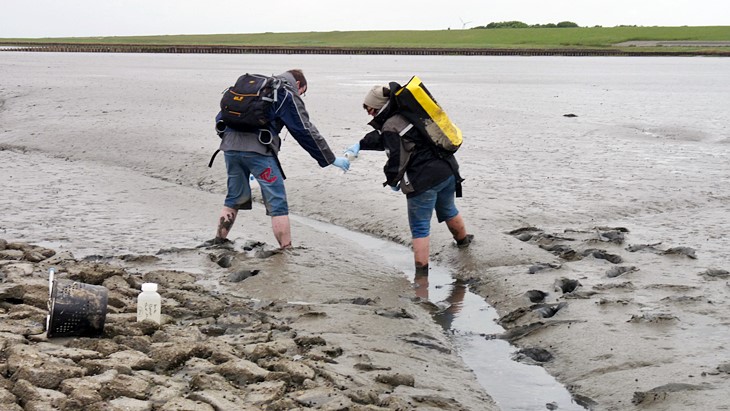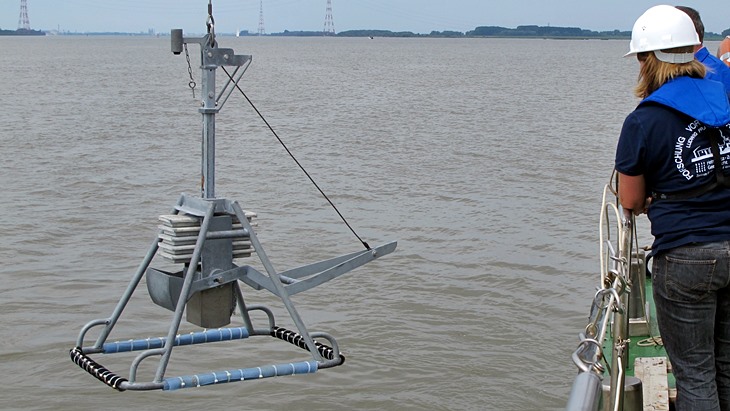How Much CO2 Does the Ocean Absorb?
The sea is the largest reservoir for the greenhouse gas carbon dioxide. As studies undertaken by researchers at the Helmholtz-Zentrum Geesthacht (HZG) show, nitrate input from land can even increase this CO2 uptake capacity. At the same time, nitrate acts as a plant nutrient, which can lead to eutrophication in coastal waters. Scientist Dr Helmuth Thomas now wants to study this discrepancy in detail with his new working group “Alkalinity”. Not least because, in the future, increasingly planned cultivation of energy crops, such as corn or rapidly growing grasses, could contribute to more and more nitrate in the sea.

Seas are a reservoir for carbon dioxide (Photo: Helmuth Thomas / HZG)
If it weren’t for the seas, climate change matters would look much worse today. This is because the seas are an enormous reservoir for the greenhouse gas carbon dioxide. Carbon dioxide – CO2 – dissolves in water, reacts with other substances and remains in this state for a long period of time. Since the beginning of the Industrial Revolution, the seas have absorbed approximately one quarter of all CO2 ever emitted by humans. If this were not the case, the Earth’s atmosphere would be considerably warmer today.
The main role in this biogeochemical interplay between atmosphere and ocean is the weathering of rocks on land. The dissolved products – such as calcium and bicarbonate (one form of CO2) – wind up in the seas via rivers. The bicarbonate is, in turn, partially converted to carbonate in the sea. The ratio of these two forms of CO2 determines the acid-binding capacity of the seawater and turns them into adversaries of carbon dioxide: CO2 reacts with water to form carbonic acid. Primarily, what is known as the carbonate ion binds the acid molecules and thus removes the CO2 gas from the water.
This chemical binding of carbon dioxide or the carbonic acid to the carbonate is an important aspect. Due to the extent that carbon dioxide is removed from the water through the carbonate equilibrium, the sea can absorb new carbon dioxide molecules from the atmosphere – and in doing so, counter the Earth’s warming.
Nitrate influences the carbonate concentration
Researchers have only in recent years been studying the question in depth as to how strongly dissolved carbonate in the sea can bind carbon dioxide and whether this ability is disrupted by climate change. What is particularly interesting is the fact that different marine regions contain varying amounts of carbonates. The concentration depends, for example, on the composition of rocks in a region and on how much precipitation occurs there, by which the carbonates are washed from the land into the sea.
Dr Helmuth Thomas, specialist at the HZG in biogeochemistry, has been looking for some time at an additional important mechanism that influences the quantity of carbonate in the sea. Carbonates, in fact, aren’t produced merely through the weathering of rocks, but also through a biogeochemical process in the sea. This is directly linked to another chemical substance: nitrate. Nitrate has been used for decades as an agricultural fertiliser. The applied nitrate, however, is only absorbed in part by the plants in the fields – extensive amounts are washed away with the rain. Experts estimate that globally approximately forty per cent of the nitrate from the fields is lost and then winds up in water bodies and in the sea.

Nitrate winds up in the soil through fertilisation with manure (Photo: Ina Frings)
Nitrate plays a special role in coastal waters, where little or no oxygen is present - for example, in the deep water layers close to the seafloor or in the sediment. This is where bacteria live that do not require oxygen for their metabolic process and instead use nitrate. In this process, known as denitrification, the microorganisms do not ultimately release CO2 as their metabolic product, but instead dissolved carbonates. This means that the more nitrate is converted in the water or in the sediment, the more carbonates are released by the microorganisms. This in the end makes more carbonate available to neutralise carbonic acid, which arises from the dissolved carbon dioxide in the water. As a consequence, ultimately the sea can absorb more carbon dioxide from the air thanks to the increased nitrate inputs.
Understanding the complex carbonate chemistry
At the beginning of the 2000s, it became clear to Helmuth Thomas how important it is to observe this mechanism more precisely. At the time, he was attempting to determine how much carbon dioxide was circulating in the North Sea. He accounted for all CO2 transports between the water, rivers, atmosphere and sediment as well as biomass such as algae. Somehow the equation didn’t work. “At some point it became clear to me that the nitrate degradation and its associated carbonate formation through denitrification must be included more accurately in the calculations in order to come to the right solution,” he says.
And so, Dr Helmuth Thomas, as one of the few experts, dove deeply into work on the complex chemistry of the sea’s carbonate in recent years. Since the beginning of 2019, he has been leading a working group at the HZG’s Institute of Coastal Research dedicated explicitly to the acid-binding capacity of carbonate – what is known as alkalinity. Together with his colleagues he has recently studied a thus far little researched aspect of climate change in more depth: the consequences that massive cultivation of energy crops could have on the sea in the future.

Energy crops such as corn and grains (Photo: Ina Frings)
The Intergovernmental Panel on Climate Change is currently discussing the cultivation of such energy crops as a measure in what is known as climate engineering. This refers to large-scale interventions by which the atmospheric carbon dioxide concentration should be reduced. Energy plants are to be grown in large monocultures so that they absorb carbon dioxide from the atmosphere as they grow. The plants are ultimately to be burnt in power plants and used in energy production. The CO2 released during burning is then to be captured and stored in underground reservoirs.
Increasing nitrate usage?
The consequences of organic plant cultivation on the environment has only been roughly estimated as yet. This is why Helmuth Thomas looked more closely at the possible consequences for the sea as part of the German-French collaborative project “Make Our Planet Great Again”. He took a future scenario set out by the Intergovernmental Panel on Climate Change which is based on the assumption that for the cultivation of energy crops of relevant magnitude, an area three times the size of India would need to be cultivated. “We’d need to use large quantities of fertiliser globally, something that is also likely to lead to a substantial increase in nitrate input in many coastal seas,” says Thomas. “With the increase of nitrate input, these regions will be able to absorb considerably more carbon dioxide through denitrification and the formation of carbonate.“
Eutrophication fears
This sounds very promising in regard to climate change. There is, however, a catch. Nitrate is known as a plant fertiliser that also greatly stimulates the growth of marine algae. A problem arises when these algal masses die. A great deal of oxygen is required in order to break down the organic substances through bacteria. Progressive degradation of the organic material without oxygen then leads in turn to denitrification and other anaerobic metabolic processes that will be exacerbated by eutrophication.
A known example is the smell of rotten eggs in the Wadden Sea, which arises from anaerobic processes. Low oxygen concentrations in the water, however, can lead to the death of fish and mussels. In some heavily over-fertilised marine regions today, there are already veritable oxygen-free dead zones. The intensive cultivation of energy crops would markedly increase this effect if we fail to produce fertiliser that is less likely to be washed away from the fields.

Taking samples in the mud flats (Photo: Ina Frings / HZG)
Discussing the advantages and disadvantages
“The advantage of increased CO2 absorption due to the nitrate is counteracted by the eutrophication in the sea – this discrepancy must be resolved before we heavily invest in cultivating energy crops,” says Thomas. Together with his new Alkalinity group at the HZG, he initially wants to investigate how such energy crop cultivation in Europe will affect the marine environment in the North Sea.
The sediments in the North Sea play a decisive role here. A fine seabed is rather low in oxygen – and rather suitable for denitrification. In contrast, hardly any nitrate degradation takes place on a rocky, oxygen-rich seabed. Thomas uses computer models for his analyses. He will also, however, take sediment samples from a research vessel with his colleagues in order to more precisely understand and take stock of the denitrification and the material turnovers locally. One destination is the fine sediment in the waters around the island of Spiekeroog. He also wants to take samples from the rather rocky ground near Helgoland.

Taking samples from the research vessel with what is known as a box corer (Photo: Sina Bold / HZG)
“In all this work, it’s important for me that I’m not seen as an advocate for nitrate as a solution strategy for climate change. The eutrophication of coastal areas with nitrate has been a serious problem for many years and in many regions – I therefore want to more precisely understand which consequences climate engineering measures, such as cultivation of energy crops, have on the sea.” Ideally, he points out, he’d like to then apply the insights from the North Sea to other marine regions around the world. This is something to strive for, as eutrophication as well as climate change are phenomena that are worrisome to people all over the world.
(Text: Tim Schröder, Science Journalist / English Translation: Anupa Srinivasan)

